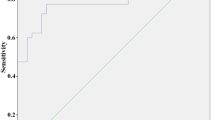Summary
An investigation was conducted to measure the levels of erythrocyte complement receptor type 1 (CR1) in patients with various rheumatic diseases other than systemic lupus erythematosus, and to evaluate the clinical significance of this receptor in patients with ankylosing spondylitis (AS) and rheumatoid arthritis (RA). Erythrocyte CR1 was measured in 37 normal controls and 106 patients with various rheumatic diseases. The levels of erythrocyte CR1 decreased significantly in patients with AS, juvenile rheumatoid arthritis, Sjögren's syndrome, and RA, while there was no statistical difference in levels of erythrocyte CR1 between normal controls and patients with gouty arthritis. This suggests that erythrocyte CR1 deficiency may occur in immune-mediated rheumatic diseases, but not in nonimmune-mediated rheumatic diseases such as crystal-induced arthritis. In this study, we noted that the levels of erythrocyte CR1 were not related to the disease activity and severity of AS. The levels of erythrocyte CR1 were also not correlated with the clinical and laboratory parameters of disease activity in RA patients. However, there was a negative association between the levels of erythrocyte CR1 and titer of rheumtoid factor in RA patients. Further study is needed to determine whether or not the level of erythrocyte CR1 is related to prognosis in patients with RA.
Similar content being viewed by others
References
Miyakawa Y, Yamada A, Kosaka K, Tsuda F, Kosugi E, Mayumi M (1981) Defective immune-adherence (C3b) receptor on erythrocyte from patients with systemic lupus erythematosus. Lancet II:493–497
Ross GD, Yount WJ, Walport MJ, Winfield JB, Parker CJ, Fuller CR, Taylor RP, Myones BL, Lachmann PJ (1985) Disease-associated loss of erythrocyte complement receptors (CR1, C3b receptors) in patients with systemic lupus erythematosus and other diseases involving autoantibodies and/or complement activation. J Immunol 135:2005–2014
Pangburn MK, Schreiber RD, Trombold JS, Muller-Eberhard HJ (1983) Proxysmal nocturnal hemoglobinuria: deficiency in factor H-like functions of the abnormal erythrocytes. J Exp Med 157:1971–1980
Kazatchkine MD, Jouvin MH, Wilson JG, Fischer E, Fischer A (1987) Human diseases associated with C3 receptor deficiencies. Immunol Lett 14:191–195
Jouvin MH, Rozenbaum W, Russo R, Kazatchkine MD (1987) Decreased expression of the C3b/C4b complement receptor (CR1) in AIDS and AIDS-related syndromes correlates with clinical subpopulations of patients with HIV infection. AIDS 1:89–94
Taylor RP, Horgan C, Buschbacher R, Brunner CM, Hess CE, O'Brien WM, Wanebo HJ (1983) Decreased complement mediated binding of antibody/3H-dsDNA immune complexes to the red blood cells of patients with systemic lupus erythematosus, rheumatoid arthritis, and hematologic malignancies. Arthritis Rheum 26:736–744
Takemura S, Deguchi M, Ueda M, Yoshida N, Kato H, Yoshikawa T, Sugino S, Kondo M (1984) C3b receptor (CR1) on erythrocytes in various diseases. Immunol Lett 7:325–328
Makela AL, Eerola E, Lehtonen OP, Ruuska P, Lantto R (1983) Erythrocyte C3b receptors in juvenile rheumatoid arthritis. N Engl J Med 309:673
Thomsen BS, Heilmann C, Jacobsen SEH, Pedersen FK, Morling N, Jakobsen BK, Svejgaard A, Nielsen H (1987) Complement C3b receptors on erythrocytes in patients with juvenile rheumatoid arthritis. Arthritis Rheum 30:967–971
Thomsen BS, Nielsen H, Bendixen G (1985) A microtiter plate enzyme-linked immunosorbent assay for measuring C3b receptors on human erythrocytes. J Immunol Methods 81:259–269
Laurent MR, Panayi GS (1983) Acute-phase proteins and serum immunoglobulins in ankylosing spondylitis. Ann Rheum Dis 42:524–528
Thomsen BS, Oxholm P, Manthorpe R, Nielsen H (1986) Complement C3b receptors on erythrocytes circulating immune complexes, and complement C3 split products in patients with primary Sjögren's syndrome. Arthritis Rheum 29:857–862
Holme E, Fyfe A, Zoma A, Veitch J, Hunter J, Whaley K (1986) Decreased C3b receptors (CR1) on erythrocytes from patients with systemic lupus erythematosus. Clin Exp Immunol 63:41–48
Walport M, Ng YC, Lachmann PJ (1987) Erythrocytes transfused into patients with SLE and hemolytic anemia lose complement receptor type 1 from their cell surface. Clin Exp Immunol 69:501–507
Uko G, Dawkins RL, Kay P, Christiansen FT, Hollings-Worth PN (1985) CR1 deficiency in SLE: acquired or genetic? Clin Exp Immunol 62:329–336
Fyfe A, Holme ER, Mckay IC, Zoma A, Hunter J, Lucie NP, Whaley K (1987) The relative roles of genetic and environmental factors in the regulation of erythrocyte C3b receptor (ECR1) numbers in normal individuals. Clin Exp Immunol 70:231–237
Wilson JG, Wong WW, Schur PH, Fearon DT (1982) Mode of inheritance of decreased C3b receptors on erythrocytes of patients with systemic lupus erythematosus. N Engl J Med 307:981–986
Wilson JG, Murphy EE, Wong WW, Klickstein LB, Weis JH, Fearon DT (1986) Identification of a restriction fragment length polymorphism by a CR1 cDNA that correlates with the number of CR1 on erythrocytes. J Exp Med 164:50–59
Rodriguez de Cordoba S, Rubinstein P (1986) Quantitative variations of the C3b/C4b receptor (CR1) in human erythrocytes are controlled by genes within the regulator of complement activation (RCA) gene cluster. J Exp Med 164:1274–1283
Feigenbaum SL, Masi AT, Kaplan SB (1979) Prognosis in rheumatoid arthritis: a longitudinal study of newly diagnosed younger adult patients. Am J Med 66:377–384
Author information
Authors and Affiliations
Rights and permissions
About this article
Cite this article
Yen, J.H., Liu, H.W., Lin, S.F. et al. Erythrocyte complement receptor type 1 in non-SLE rheumatic diseases. Rheumatol Int 10, 71–73 (1990). https://doi.org/10.1007/BF02274786
Received:
Accepted:
Issue Date:
DOI: https://doi.org/10.1007/BF02274786




